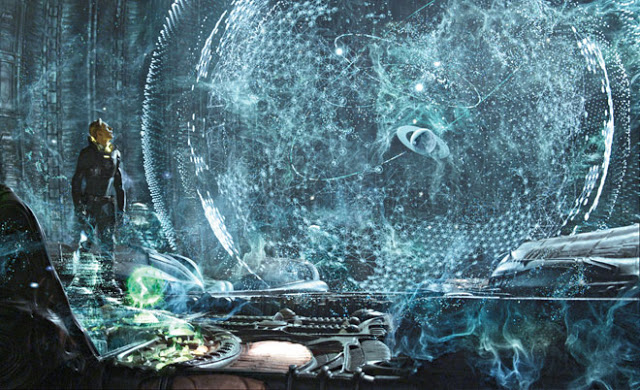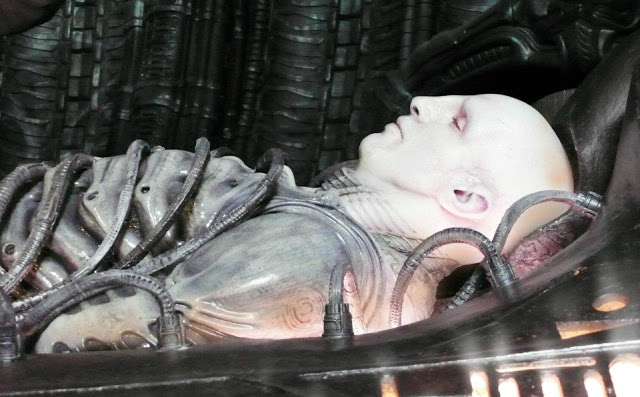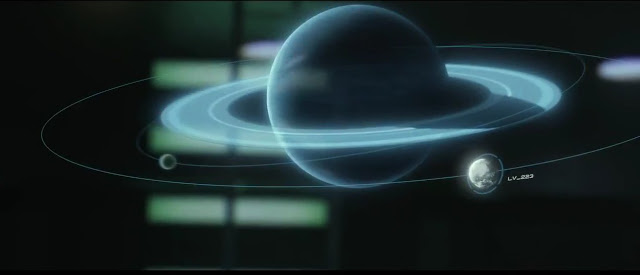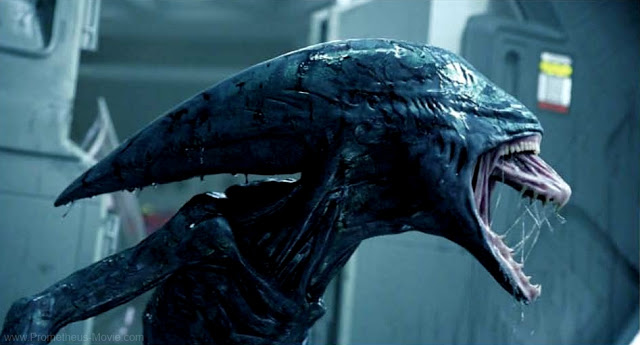Granted, it’s no Alien or Aliens, but Ridley Scott’s beautiful, provocative and frustrating Prometheus easily surpasses the grim Alien 3 and the schlocky Alien: Resurrection.
If it’s not all we die-hard fans were hoping for, it’s at least a springboard for what should become a series of Alien prequels.
Some perspective: I stopped reading spoilers and speculation on Prometheus shortly after I learned Ridley Scott would be directing it, right around the time we learned in the blogosphere that the project had evolved from a direct Alien prequel to something more independent, but would nonetheless contain the series’ recognizable DNA, yada, yada.
Having contemplated the film’s lofty ambitions, digested its ginormous scope, marveled at its gorgeous production design and, yes, nitpicked over its frustrating plot incongruities, I offer a few observations that not only answer some of the film’s most burning criticisms, but also point to a larger story arc that connects more comfortably with the established events preceding Alien.
Tread carefully: there be spoilers here.
If, like me, you left Prometheus in a Phantom-Menace-like daze of awe and confusion over perplexing plot holes and seeming incongruities in the Alien timeline, it may have less to do with sloppy screenwriting (a handy scapegoat) or overzealous whittling (an optional expanded cut on the forthcoming Blu-ray will run 20 minutes longer) and more to do with the fact that this is evidently a first chapter in an envisioned series of Alien predecessors.
Only after seeing the film did I recall early rumblings that the “Alien Prequel” would be a two-parter. Way back when, the first thing I thought when I read this would be a two-parter was, “Great, Part 1 won’t have a satisfying climax.”
I was right.
After a steady and suspenseful build-up, I was quick to poo-poo the film’s rushed climax, frustrated that the puzzle I was piecing together throughout the course of the film did not fit the finished picture I had in mind.
Because the picture isn’t finished yet.
Knowing this film is a launching point for further adventures that take place before the events of Alien, you’ll perhaps be more forgiving of Prometheus’ tendency to answer its most burning questions with more questions.
Such as… What’s with the holographic images of the Engineers being killed? Since the green blood of a slaughtered Engineer is still moist on the pyramid wall, how soon after this carnage does crew of Prometheus arrive? What are David’s motives, aside from plot conveniences, for poisoning Dr. Halloway with the mysterious black goo? If the flying red laser orbs have mapped out the interior of the hollow pyramid for everyone to see on their wrist monitors, how is it that the geologist and his cohort get lost while trapped inside? Why would Meredith Vickers’ personal surgical pod in her dedicated life boat be calibrated only for males? Why does Peter Weyland need to conceal his presence on the ship from the rest of the crew?
There’s more to come, to be sure, but what to make of the film at face(hugger) value?
The film begins with a spectacular sequence that shows what we assume is the creation of life on Earth, but we cannot know for certain when this moment takes place. We cannot even assume this event takes place on Earth. Neither time nor location is identified.
Eagle-eyed viewers will spot the film’s most crucial tell: we’re not on the familiar planet LV-426 as explored in Alien and Aliens. The screenplay is very cagy in glossing over important details such as the mission destination of Prometheus (the text on screen reads simply “Undisclosed”), but in the hologram sequence we can see they’re heading towards a planet labeled LV-223. It’s a small detail, and one that’s never spoken, but a vital one that explains the film’s most nagging geographical incongruities.
Ardent fans no doubt sat up and took notice when it turned out the buried ships under the pyramids on LV-223 are identical to the derelict vessel we know from Alien, and the navigators (referred to here as “Engineers”) are the beings we’ve come to recognize as the race of “Space Jockeys” seen—but never named as such—in the original Alien.
Purists no doubt scoffed when the murderous Engineer is attacked by the giant sperm/squid creature during the climax of Prometheus because we know from Alien that the “Space Jockey” is killed by a chest-burster while seated in the navigator’s chair of one of those C-shaped space ships. But considering we’re not on planet LV-426, and the crashed crescent-shaped vessel is one of a vast fleet, it should be obvious to the most attentive viewer that we haven’t yet connected to these particular plot strands of Alien.
Leave it to the puppet-master behind TV’s Lost to toy with our expectations of what we already know will eventually happen, but instead slip us a mickey: what we assume to be directly liked to plot points in Alien is a collective red herring. In short: Different planet, different ship, different crash landing, different “Space Jockey.”
So the spectacular mid-air collision that sends the croissant vessel tumbling to the surface at the end of Prometheus is not the same ship Tom Skerritt and John Hurt penetrate in Alien.
It’s therefore not the same ship Newt’s parents plunder in the expanded cut of Aliens. This obviously means there’s more than one crash landing of a croissant-shaped ship in the timeline leading up to the exploits of Ellen Ripley and the crew of the Nostromo.
There’s more than one oversized Engineer with a chest wound. One of those guys will eventually be felled by a chest-burster while sitting in the navigator’s seat. He’ll be discovered in Alien by Tom Skerritt and John Hurt. We already know there are a few more ships parked underneath the pyramids on LV-223.
Rest assured, a ship just like it will eventually crash land on what will come to be known as LV-426. We just haven’t seen it depicted yet.
A subtle architectural flourish serves as further evidence: The cryo-chambers circling the perimeter of the navigation console in Prometheus are nowhere to be seen when the crew of the Nostromo explore the innards of the stranded vessel in Alien. What I reflexively chalked up as a sloppy design omission suddenly made more sense once I recognized the probability that this was an entirely different ship.
All of this connects to the realization that we still haven’t yet visited the alien “home planet,” a destination shamelessly teased in the final beats of Prometheus as heroine Elizabeth Shaw pilots a commandeered croissant ship into hyperspace.
A few other plot points that hint at a firmer connection with Alien: the corporation Weyland Industries in Prometheus will one day undergo a merger to become the treacherous Weyland-Yutani Corporation as depicted in the Sigourney Weaver films.
Look sharp and you’ll recognize the giant sperm/squid that kills the Engineer is the first evolution of the dreaded face-hugger, and the creature that bursts from the Engineer’s chest—with its elongated phallus-shaped cranium and its retractable teeth—is a primitive version of what we should all recognize as the titular xenomorph of Alien.
A few parting words on 3D versus 2D.
The (fake) digital IMAX 3D image is sumptuous, tending towards vast perspective and enormous scale effects versus cheap in-your-face stunts. There’s no denying the visceral thrill of hovering over a tremendous waterfall while an impossibly huge flying saucer pokes through the clouds overhead, but nothing in Prometheus really cries out for 3D.
In fact, the film might’ve benefited from a few creature-lunging, acid-spewing-at-the-audience gags. None of the you-are-there dimensional effects was worth the stab of pain I experienced in my left eyeball less than halfway through the film, no doubt a result of the dimming inherent in wearing the 3D goggles in the first place.
I confess I prefer the flat and brighter 2D version, which is just as gorgeous and is actually more aesthetically pleasing in the wider 2.35:1 aspect ratio (the fake IMAX presentations are compromised at a narrower aspect ratio to fill the boxier digital-IMAX screens).
I’ve said it before and I’ll say it again: I’m done with 3D.


















































































































